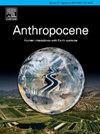Highland transformation: Human impact in the Bukov Brook valley (Bohemian-Moravian Highlands) from Prehistory to the modern era
IF 3.3
2区 地球科学
Q2 ENVIRONMENTAL SCIENCES
引用次数: 0
Abstract
The history of human activities in the Central European mid-mountains differs significantly from the intensively inhabited lowlands. The Bohemian-Moravian Highlands are believed to have been settled during the onset of metal mining in the 13th century AD. Our evidence from the floodplain deposits of Bukov Brook demonstrates deforestation and sporadic human settlement activities during the prehistoric era, already occurring as early as the Bronze Age, as evidenced by pottery, charcoal and Lens culinaris cf. in the alluvial fan sediments. In this period, the landscape was covered by Abies and Fagus. Since the 10th–12th centuries AD, an agricultural landscape with mild deforestation has been inferred from buried floodplain sediments, despite limited archaeological evidence of settlement. Significant geomorphological changes were observed in the 11th–13th centuries AD, driven by prospecting, mining activities, pond construction, and intensive deforestation, accompanied by the limited presence of cultivated grain. Between the 13th and 16th centuries AD, mining activities ceased, anthropogenic influence increased, and the deforested landscape became more conducive to agriculture, grain cultivation, and grazing. From the 16th century AD onwards, erosion from fine washouts of fields and pastures became prevalent, and the once-functional pond vanished. This comprehensive picture underscores the role of smaller catchments in mid-mountain regions like the Bohemian-Moravian Highlands highlighting their significance in the research of landscape transformation, resource exploitation, and land-use practices. It also sets the stage for further exploration into the evolving dynamics of human-environment interactions across various historical periods.
高地改造:人类对布科夫溪谷(波西米亚-摩拉维亚高地)从史前到现代的影响
中欧中部山区的人类活动历史与密集居住的低地有很大不同。波希米亚-摩拉维亚高地被认为是在公元13世纪金属采矿开始时就有人定居的。我们从布科夫河河漫滩沉积物中获得的证据表明,在史前时代,森林砍伐和零星的人类定居活动早在青铜时代就已经发生了,冲积扇沉积物中的陶器、木炭和Lens culinaris就是证据。在这一时期,景观被冷杉和Fagus覆盖。自公元10 - 12世纪以来,从被掩埋的洪泛区沉积物中推断出了一个轻度砍伐的农业景观,尽管考古证据有限。在公元11 - 13世纪,由于勘探、采矿活动、池塘建设和密集的森林砍伐,伴随着有限的粮食种植,发生了重大的地貌变化。在公元13至16世纪之间,采矿活动停止,人为影响增加,森林被砍伐的景观变得更有利于农业、粮食种植和放牧。从公元16世纪开始,农田和牧场的侵蚀变得普遍,曾经的功能池塘消失了。这幅综合图强调了波希米亚-摩拉维亚高地等中部山区较小集水区的作用,突出了它们在景观转变、资源开发和土地利用实践研究中的重要性。它还为进一步探索不同历史时期人类与环境相互作用的演变动态奠定了基础。
本文章由计算机程序翻译,如有差异,请以英文原文为准。
求助全文
约1分钟内获得全文
求助全文
来源期刊

Anthropocene
Earth and Planetary Sciences-Earth and Planetary Sciences (miscellaneous)
CiteScore
6.30
自引率
0.00%
发文量
27
审稿时长
102 days
期刊介绍:
Anthropocene is an interdisciplinary journal that publishes peer-reviewed works addressing the nature, scale, and extent of interactions that people have with Earth processes and systems. The scope of the journal includes the significance of human activities in altering Earth’s landscapes, oceans, the atmosphere, cryosphere, and ecosystems over a range of time and space scales - from global phenomena over geologic eras to single isolated events - including the linkages, couplings, and feedbacks among physical, chemical, and biological components of Earth systems. The journal also addresses how such alterations can have profound effects on, and implications for, human society. As the scale and pace of human interactions with Earth systems have intensified in recent decades, understanding human-induced alterations in the past and present is critical to our ability to anticipate, mitigate, and adapt to changes in the future. The journal aims to provide a venue to focus research findings, discussions, and debates toward advancing predictive understanding of human interactions with Earth systems - one of the grand challenges of our time.
 求助内容:
求助内容: 应助结果提醒方式:
应助结果提醒方式:


